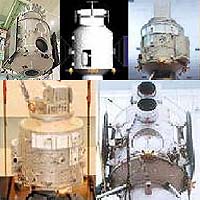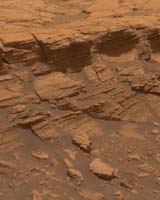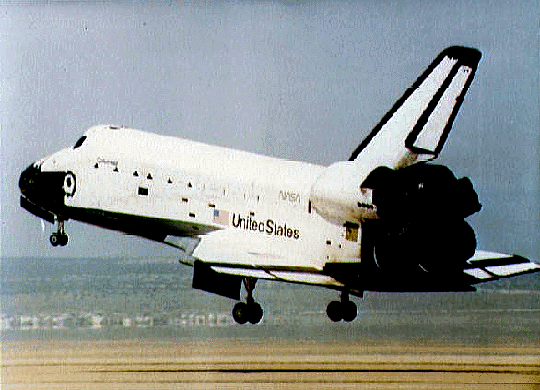27 April 2006
+ 0 - 1 | § ¶Congrats, Crip!
 Per NASA:
Per NASA:
Former NASA astronaut Bob Crippen, pilot on the first space shuttle mission in 1981, has been honored with the nation's highest award for spaceflight achievement, the Congressional Space Medal of Honor.
Twenty-eight astronauts have been honored with the award, 17 of them posthumously. Crip's recognition is well-deserved, and I'm glad to see him receive it.
+ 0 - 2 | § ¶Happy Anniversary, Stennis

I'm late posting this, but happy anniverary to Mississippi's Stennis Space Center, which on Sunday
celebrated 40 years of rocket engine testing.
"At the time the Mississippi Test Facility (as it was then called) was built, it was the largest construction project in Mississippi and the second largest in the United States."
What's going to be really cool, though, is when, in the next few years, things get old-school at Stennis. The first engine test at Stennis in 1966 was of five J-2 engines, on a Saturn rocket stage developed to go to the moon. Before too long, it appears Stennis will once again begin testing J-2 rocket engines, once again developed to go to the moon.
26 April 2006
+ 1 - 1 | § ¶STS-121 Update

Since I've already run one big picture today, and since I did a slightly different version of this yesterday, I'm having to fight the temptation to run this as a giant picture today. Darned if it isn't pretty, though.
The larger image, and others, can be found at the
KSC STS-121 Multimedia page.
25 April 2006
+ 1 - 0 | § ¶STS-121 Update

ET-119, the external tank scheduled for use on the STS-121 shuttle flight, was
hoisted into the vertical position yesterday in preparation for the tank to be mated to a pair of solid rocket boosters today, beginning the stacking process for the mission, currently scheduled for July.
(Of course, there could still be
issues to be worked out down the road. But it's nice to see the assembly process begin.)
+ 0 - 2 | § ¶Dark Star
 UPDATE: The link has been fixed. Thanks, Jordan.
UPDATE: The link has been fixed. Thanks, Jordan.It's an idea that's long been the topic of speculation, but there's been little to no actual, you know, evidence for it.
Now, though, a group of astronomers are saying that the highly unusual orbit of the KBO Sedna provides physical evidence that
our sun has a companion star.
It's a counterintuitive idea on the surface; as a layman it's hard to believe astronomers could miss an entire star in our backyard, but apparently it's possible. The article speculates that the search for such a star may be gaining momentum.
24 April 2006
+ 2 - 0 | § ¶Shenzhou VII Update

China announced a while back that its next manned spaceflight, Shenzhou VII, would not be launched until 2008, creating a longer gap between flights than occurred between the first two, but an early 2008 launch could have meant a delay of only two years and two months, which wouldn't have been terribly much longer.
Now, though, they've announced that the mission won't launch until Sept. 2008 after the Beijing Olympics,
nearly three years after Shenzhou VI.
The third Soviet spaceflight came just over one year after the second. The third U.S. spaceflight was only seven months after the second, and used an entirely different launch vehicle. The Chinese program has the advantage of access to modern technology and decades of spaceflight history, and yet flies a program that, going full steam, is equivalent to NASA's flight rate when the fleet is grounded.
I don't understand why anyone takes the Chinese space program seriously, when they clearly don't themselves.
20 April 2006
+ 1 - 1 | § ¶Godspeed, Scott Crossfield
 Test pilot Scott Crossfield has made his final flight.
Test pilot Scott Crossfield has made his final flight.
17 April 2006
+ 0 - 1 | § ¶Shoeless Yuri

I hate resorting to do big quote posts in a row, but I found this bit about
why Yuri Gagarin was chosen for the first manned spaceflight interesting:
He was hand picked for one of humanity's greatest ever solo missions - the Soviet Union's bid to stake the hammer and sickle flag in the heavens. But, 45 years after Yuri Gagarin became the first man in space, the real reason why he was chosen for his country's high honour has finally emerged. Contrary to popular myth, the deciding factor that won him the single seat in Vostok I ahead of five other candidates was not his physical toughness, his psychological resilience or even his impeccable proletarian credentials. Instead, it was the fact that he took his shoes off when climbing into a prototype of the craft for a look around. Touched by such a show of respect, the head of the space exploration programme, Sergei Korolev, decided that Gagarin should be the man for the historic 108 minute flight into space in April 1961.
+ 0 - 1 | § ¶Antimatter, New And Improved
 Per NASA:
Most self-respecting starships in science fiction stories use antimatter as fuel for a good reason its the most potent fuel known. While tons of chemical fuel are needed to propel a human mission to Mars, just tens of milligrams of antimatter will do (a milligram is about one-thousandth the weight of a piece of the original M&M candy).
Per NASA:
Most self-respecting starships in science fiction stories use antimatter as fuel for a good reason its the most potent fuel known. While tons of chemical fuel are needed to propel a human mission to Mars, just tens of milligrams of antimatter will do (a milligram is about one-thousandth the weight of a piece of the original M&M candy).
However, in reality this power comes with a price. Some antimatter reactions produce blasts of high energy gamma rays. Gamma rays are like X-rays on steroids. They penetrate matter and break apart molecules in cells, so they are not healthy to be around. High-energy gamma rays can also make the engines radioactive by fragmenting atoms of the engine material.
The NASA Institute for Advanced Concepts (NIAC) is funding a team of researchers working on a new design for an antimatter-powered spaceship that avoids this nasty side effect by producing gamma rays with much lower energy.
...
Another significant advantage is speed. The Reference Mission spacecraft would take astronauts to Mars in about 180 days. "Our advanced designs, like the gas core and the ablative engine concepts, could take astronauts to Mars in half that time, and perhaps even in as little as 45 days," said Kirby Meyer, an engineer with Positronics Research on the study.
+ 0 - 2 | § ¶Winter Wonderland

The Mars rover Spirit has reached a location mission planners believe
will be safe for spending the Martian winter, providing enough sunlight for the rover to keep its batteries charged. Just as Mars' orbit is longer than Earth's, so is its winter -- Spirit will have to spend the next eight months in the limited area of Low Ridge Haven. Despite the fact that this means Spirit will be confined for a period of time almost three times as long as the original mission duration, controllers are excited -- being stuck gives them the luxury to conduct in-depth investigations and longitudinal studies they couldn't afford to do when the next destination was calling.
14 April 2006
+ 2 - 1 | § ¶Today In History

On this date 25 years ago, the first space shuttle mission came to a successful conclusion at John Young and Bob Crippen returned Columbia to Earth on its STS-1 flight.
+ 3 - 0 | § ¶STS-121
 Per Spaceflight Now:
During wind tunnel tests earlier this week, NASA subjected a full-scale mockup of a shuttle external tank section to aerodynamic forces greater than a real tank would experience during launch. In one series of tests, unmodified foam insulation used to prevent ice buildups around external fittings suffered only minor damage while a redesigned "ice/frost ramp" suffered major foam loss.
Per Spaceflight Now:
During wind tunnel tests earlier this week, NASA subjected a full-scale mockup of a shuttle external tank section to aerodynamic forces greater than a real tank would experience during launch. In one series of tests, unmodified foam insulation used to prevent ice buildups around external fittings suffered only minor damage while a redesigned "ice/frost ramp" suffered major foam loss.
The redesign is being considered in a bid to remove as much insulation as possible from the tank to minimize the threat of debris shedding during launch. The old ice/frost ramps, which insulate the fittings used to hold two pressurization lines and an electrical cable tray in place, featured long, sloping ramps to smooth the flow of air.
But those very ramps, it was believed, were susceptible to cracks and failure, providing a potential source of debris that could strike a shuttle during launch. The redesigned ramps are much more blunt. But in initial wind tunnel tests at the Arnold Engineering Development Center in Tullahoma, Tenn., the old design fared better than the redesign. During two sets of test runs this week, the new design suffered major foam loss.
"That's exactly what testing is all about," said one official. "This is where you want to find a problem, not on launch day."
13 April 2006
+ 0 - 3 | § ¶STS-121

For what it's worth, STS-121 commander Steven Lindsey says he's
"pretty optimistic that we're going to make July" for the launch.
12 April 2006
+ 1 - 1 | § ¶Twenty-Five Years!

On April 12, 1981, commander John Young and pilot Bob Crippen made what has been called the "boldest test flight in history" -- STS-1, the first flight of the space shuttle Columbia.
+ 0 - 2 | § ¶Poyekhali!

On this date 45 years ago, the era of human spaceflight began with the launch of
Vostok 1, manned by cosmonaut
Yuri Gagarin.
+ 1 - 1 | § ¶Shrinking Xena

It turns out that 2003 UB313 (or, if you prefer -- sigh -- "Xena") is
only slightly bigger than Pluto, according to new images from the Hubble Space Telescope (In which the world is only 1.5 pixels across). Previously it had been believed that due to the objects brightness it
had to be substantially larger than the ninth planet, but now scientists are saying it must be much more reflective than initially believed, possibly the second-most-reflective object known.
Still no word from the IAU as to whether this KBO will be dubbed a planet. I would hope this would help the non-planet case, but, since it's still apparently slightly larger than Pluto, it probably won't make much of a difference.
11 April 2006
+ 2 - 0 | § ¶To The Moon! Zoom! Bang!
 Per NASA:
NASA will send an impactor spacecraft to the moon with the launch of the Lunar Reconnaissance Orbiter, scheduled for October 2008. The Lunar Crater Observation and Sensing Satellite will travel independently of the orbiter and crash into the lunar surface to search for water ice.
Per NASA:
NASA will send an impactor spacecraft to the moon with the launch of the Lunar Reconnaissance Orbiter, scheduled for October 2008. The Lunar Crater Observation and Sensing Satellite will travel independently of the orbiter and crash into the lunar surface to search for water ice.
First, the craft will direct the upper stage used to leave Earth orbit to crash into a permanently-shadowed crater at the lunar south pole, creating a plume visible to Earth-based observatories. Next, the satellite will observe the plume and fly through it using several instruments to look for water. At the end of its mission, the satellite will itself become an impactor, creating a second plume visible to lunar-orbiting spacecraft and Earth-based observatories.
An interesting bit of history, though, per Wikipedia: "The [
Lunar Prospector] mission ended on 31 July 1999 at 9:52:02 UT (5:52:02 EDT) when Lunar Prospector was deliberately targeted to impact in a permanently shadowed area of the Shoemaker crater near the lunar south pole. It was hoped that the impact would liberate water vapor from the suspected ice deposits in the crater and that the plume would be detectable from Earth; however, no such plume was observed."
Doing some further reading, I found a
New York Times article that appears to be the only one out now that acknowledges the old mission in discussing the new. It says the problem with Prospector may have been the shallow impact angle, something I would assume has been compensated for with LCROSS.
+ 0 - 2 | § ¶To Venus, Orbiting

The European Space Agency's
Venus Express spacecraft has reached our sister world and has entered orbit. Based on ESA's Mars Express spacecraft, Venus Express is the first visitor to the clouded world in 16 years. While it will take almost a month for the spacecraft to draw closer to the planet into its final orbit, it will begin scientific operations this week, while it's still far enough out that it can image the entire planet at once. By June 4, Venus Express should begin its true science operations phase, which will last two days. (Er, at Venus, at least -- that's 486 Earth days.)
10 April 2006
+ 1 - 0 | § ¶Following Footsteps
 Per ynetnews.com:
Since the Space Shuttle Columbia disaster three years ago that claimed the life of Israel's first astronaut, Ilan Ramon, Assaf Ramon has said he hoped to follow in the footsteps of his illustrious father.
Per ynetnews.com:
Since the Space Shuttle Columbia disaster three years ago that claimed the life of Israel's first astronaut, Ilan Ramon, Assaf Ramon has said he hoped to follow in the footsteps of his illustrious father.
Last week, he took the first step towards realizing that dream: After completing the exhausting first-stage trials, Ramon was notified that he'd passed the initial test and has been accepted one of the IDF's most exclusive courses, figther-pilot training.
About a year after losing his father, then-16-year-old Ramon said he wanted to be an astronaut.
"Israel must send another astronaut," Ramon confidently told Yedioth Ahronoth, Israel's leading daily. He said that his first step to outer space would be to emulate another of his father's accomplishments: to serve as a combat pilot in the Israel air force.
+ 1 - 0 | § ¶Looking Back On The Beginning

Wednesday marks the 25th anniversary of the launch of the first space shuttle mission, STS-1. To mark the occasion, collectSPACE has posted a really interesting
interview with John Young and Bob Crippen, the commander and pilot of Columbia on that first flight.
Keywords: collectspace,history,nasa,space,space_shuttle
+ 1 - 1 | § ¶Back On Earth
 Per NASA:
Commander Bill McArthur and Flight Engineer Valery Tokarev, the 12th crew of the International Space Station, landed in the steppes of Kazakhstan in their Soyuz spacecraft at 7:48 p.m. EDT Saturday after about 190 days in space.
Per NASA:
Commander Bill McArthur and Flight Engineer Valery Tokarev, the 12th crew of the International Space Station, landed in the steppes of Kazakhstan in their Soyuz spacecraft at 7:48 p.m. EDT Saturday after about 190 days in space.
With them was Marcos Pontes, the first Brazilian astronaut, who flew to the space station with the Expedition 13 crew and spent about eight days doing experiments. He was aboard under a contract with the Russian Federal Space Agency (Roscosmos).
07 April 2006
+ 0 - 1 | § ¶"Sugar Coating Reality"

So the
NASA Kids Club made NASA Watch yesterday, and, naturally for the post-Cowing-coddling era, in a negative way. And, really, it wasn't the Kids Club, per se, but a kids' feature that was written around Return To Flight that is linked to from the new Kids Club. (Point being, the material has been online for the better part of a year, but NASA Watch is just now noticing it.)
The piece quotes an item from
this list of Space Shuttle facts:
There have been six Space Shuttles. The names are: Enterprise, Columbia, Challenger, Discovery, Atlantis and Endeavour. Three of them -- Discovery, Atlantis and Endeavour -- are still working.
Responding to the item, Cowing writes:
Editor's note: Its great that NASA has this kids website online - and more should be created. But NASA needs to be a little more honest with ts audience. I am not advocating scare tactics with regard to kids, but two of the Space Shuttles are not "working" because they were destroyed during their missions - killing all aboard. Perhaps a note to the kids about how risky space travel can be - and how this inspires NASA to try and make it safer - and that important things such as exploration can sometimes lead to loss of life. There's news about Iraq on TV every night - and most kids cartoons feature a lot of violence - so its not as if they are isolated from the realities of life. But to ignore two fatal accidents is not how you honor sacrifice - or inform the next generation.
I'm not going to argue that NASA should try and cover up the fact that two shuttles were lost, or even hide that from children. I would argue, however, that that list of brief shuttle facts is not the place to do it. Adequately explaining what happened and when and why would take more time and space than would be appropriate for that. If NASA were trying to cover up the lost shuttles, it would have been easy to say "Today, there are three space shuttles." The way it's handled doesn't get into what happened to the other two (it is mentioned later that Enterprise never flew), but it opens the door for readers to find out on their own. Just my two cents (and, natch, my opinions are only my own.)
05 April 2006
+ 1 - 0 | § ¶Trip To Space, $3

Well, kinda. Actually, it's no cheaper than $54, but that's still not half bad for a trip into orbit.
Space Shot has created
an online game, with a prize of a suborbital spaceflight. While billed as a game of skill, there's more than a little element of chance, and it's barely a game. For $3, you predict the next day's weather in Central Park. Contestants compete in pairs; if your prediction proves more accurate than your opponent's, you advance to the next level. Reach Level 18, and you win a trip into space on the in-development Rocketplane XP (Hey, haven't those letters already appeared on the blog today?).
While the result seems to be a concerted effort to send more meteorologists into space, it is cool to see another program to give average folks a chance to fly.
+ 2 - 0 | § ¶A Night In The Airlock
 Updated 12:38 p.m.
Per Spaceflight Now:
The incoming and outgoing crews of the international space station have settled in for a week of hand-over work, along with an overnight "camp out" test aimed at making preparations for future spacewalks more efficient.
Updated 12:38 p.m.
Per Spaceflight Now:
The incoming and outgoing crews of the international space station have settled in for a week of hand-over work, along with an overnight "camp out" test aimed at making preparations for future spacewalks more efficient.
...
This evening, McArthur and Williams will spend the night in the space station's Quest airlock module as part of a test to demonstrate how future space shuttle assembly crews can use the module to more efficiently purge their bodies of nitrogen to prevent the bends during excursions in low-pressure space suits.
Per Florida Today:
Two U.S. astronauts cut short a "campout" on the International Space Station on Tuesday after an alarm indicated potentially risky conditions inside the outpost's American airlock.
...
However, two alarms went off after the astronauts went to sleep. The second indicated carbon dioxide levels might be too low in the airlock, prompting ground controllers to stop the "campout" five hours into a planned 8.5-hour sleep period.
Engineers think the warning signals were false alarms. They are not sure what set them off and are trying to determine the cause, Herring said.












 I'm late posting this, but happy anniverary to Mississippi's Stennis Space Center, which on Sunday
I'm late posting this, but happy anniverary to Mississippi's Stennis Space Center, which on Sunday  Since I've already run one big picture today, and since I did a slightly different version of this yesterday, I'm having to fight the temptation to run this as a giant picture today. Darned if it isn't pretty, though.
Since I've already run one big picture today, and since I did a slightly different version of this yesterday, I'm having to fight the temptation to run this as a giant picture today. Darned if it isn't pretty, though.
 UPDATE: The link has been fixed. Thanks, Jordan.
UPDATE: The link has been fixed. Thanks, Jordan. China announced a while back that its next manned spaceflight, Shenzhou VII, would not be launched until 2008, creating a longer gap between flights than occurred between the first two, but an early 2008 launch could have meant a delay of only two years and two months, which wouldn't have been terribly much longer.
China announced a while back that its next manned spaceflight, Shenzhou VII, would not be launched until 2008, creating a longer gap between flights than occurred between the first two, but an early 2008 launch could have meant a delay of only two years and two months, which wouldn't have been terribly much longer.
 I hate resorting to do big quote posts in a row, but I found this bit about
I hate resorting to do big quote posts in a row, but I found this bit about 
 The Mars rover Spirit has reached a location mission planners believe
The Mars rover Spirit has reached a location mission planners believe 


 It turns out that 2003 UB313 (or, if you prefer -- sigh -- "Xena") is
It turns out that 2003 UB313 (or, if you prefer -- sigh -- "Xena") is 
 The European Space Agency's
The European Space Agency's 
 Wednesday marks the 25th anniversary of the launch of the first space shuttle mission, STS-1. To mark the occasion, collectSPACE has posted a really interesting
Wednesday marks the 25th anniversary of the launch of the first space shuttle mission, STS-1. To mark the occasion, collectSPACE has posted a really interesting 
 So the
So the  Well, kinda. Actually, it's no cheaper than $54, but that's still not half bad for a trip into orbit.
Well, kinda. Actually, it's no cheaper than $54, but that's still not half bad for a trip into orbit. Updated 12:38 p.m.
Updated 12:38 p.m.